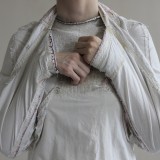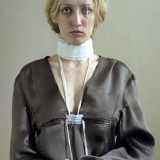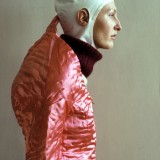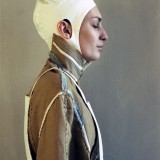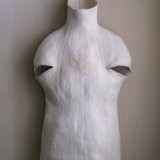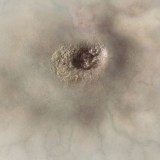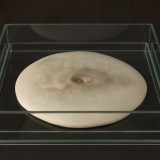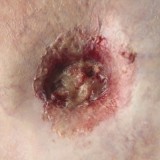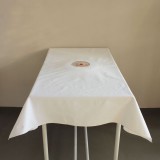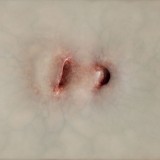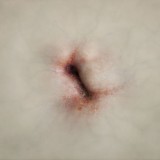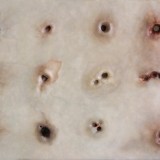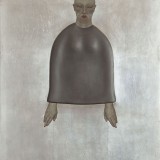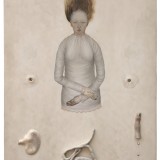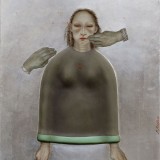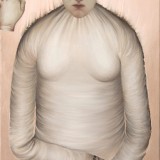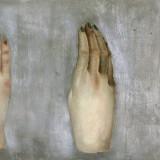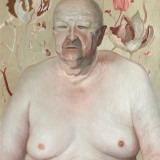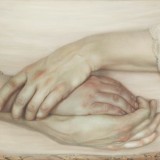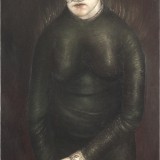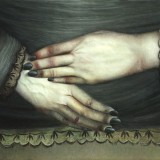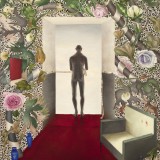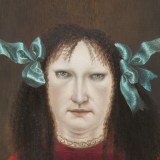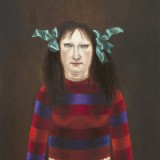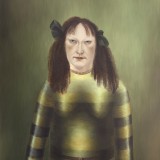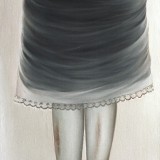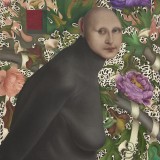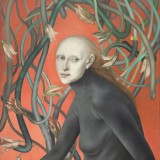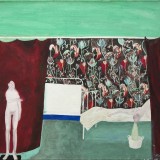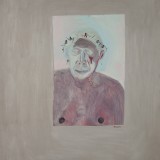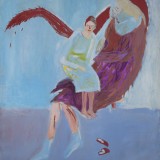Magdalena Moskwa
Magdalena Moskwa (born 1967) studied at the Art College in £ód¼ (now the Academy of Fine Arts) and graduated in 1996 from the Studio of Decorative Print run by Prof. Maria Zielińska. In 1994 she received a scholarship from the Ministry of Culture and Art. She works mainly in painting and since 1995 she has also designed clothes.
The artist started with expressive, figurative scenes, placed on a modest, neutral background. Some of the paintings had also featured text comments which gave them a reflective character and directed the attention of the viewer towards topics of spirituality. Then within her art there began to appear portraiture and very characteristic figures which became identified with her style. In the beginning she presented on upper part of the body against a uniform, smooth background. The protagonists of her works are usually women, who often stay anonymous, somewhat unreal, as if they were from another world: pale, frozen in time, with narrow, almond-like eyes and with faces which resemble masks. Their faces are easy to recognise, which connects the strength of the psychological portrait with the peace and simplicity of icons.
The artist created a collection of unique clothes. The printed and embroidered fabrics out of which the clothes are made, are also designed by the artist. In her collection there also appear clothes which resemble stiff overalls, which look like armour in which one can encase his/her body. The impression of stiffness is highlighted by the visible seams and underside parts of the clothes. It appears as if we are looking at that which is usually hidden – the underside of a piece of clothing. It is similar in her painting, in which she doesn’t concentrate on showing the portrayed subjected in detail, but rather express a certain kind of energy.
Magdalena Moskwa is well known for her portraits. Well known are those, in which backgrounds are filled with flower-motifs which often create a very complicated pattern. Most often the artist leaves the background uniform, but paints it in a way that there is an almost unnoticeable, subtle play of light and shadow. It allows the viewer to concentrate one’s entire attention on the person portrayed. She also started to compose the frame in a way which is unusual for a portrait, it only shows a fragment of a person – for example one can see clasped hands and a chin, the remaining part of the face being outside the frame of the painting. Recently she has created paintings on which there are only fragments of bodies, for example hands by which she can express the same emotions as within a classic portrait. She is also able to express a specific atmosphere of understatement about the presented figures, a certain mystery.
In her portraits which she constantly creates, an interest in the body became a new element or more precisely, a specific kind of corporality, which is revealed by adding tiny organs to them (resembling for example kidneys), placed by the artist behind glass. Since 2004 the artist has used a chalk grout which enabled her to make reliefs on the surface of the painting, and through it also to place small objects in them. It is worth paying attention to the artists broadening of techniques including the use of relief and paintings created on silver. Moskwa is able to give physicality to objects – for example to a frame, by painting it flesh-coloured and adding a navel. She also enters small ready elements from everyday life such as artificial nails added by the artist to the painted hands. Hands are a very important element in Moskwa’s art and are treated in a special way: as a part of the body, which says as much about a person as does the face.
Among the newest works there are those which are finished with a relief and are very strongly connected to abstraction. They resemble close-ups of body fragments, wounds, skin, some organic forms. They are painted just like portraits and a similar energy is expressed through them. In 2013 in the Wozownia Gallery in Toruń the artist had her exhibition entitled The Corporeality of the Painting and it seems that it is one of the most accurate descriptions of Magdalena Moskwa’s search within the genre of painting.
Karolina Jab³ońska
more at the artist's web site:


